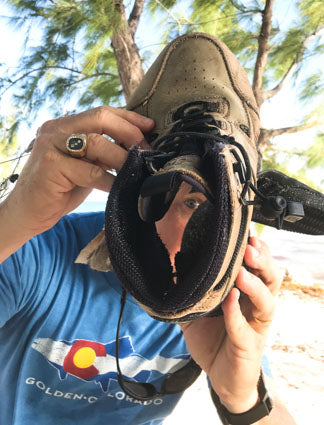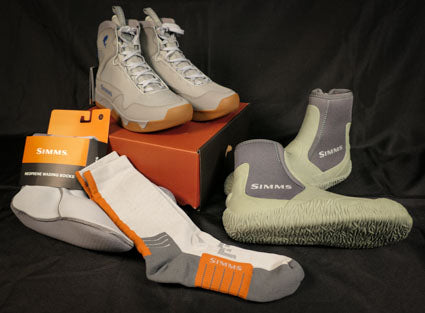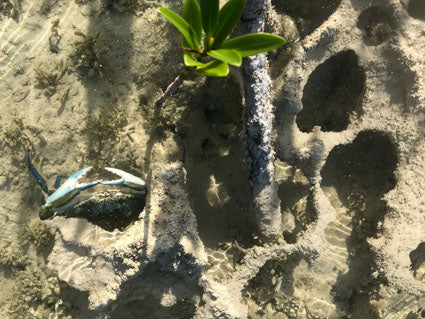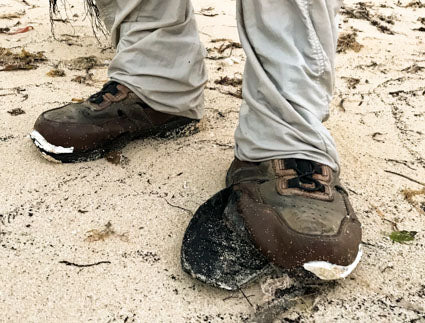The Setup
Me: “Hey Andy, those boots are looking a little rough. I think the sole is starting to separate”
Andy: “Oh, you’re right. I’ll have to take care of that.”
Me: “You should pick up a new pair before Andros. I don’t think those are going to hold up.”
Andy: “They’ll be alright. I’ll get some 5200 and glue the sole back on.”
Lost Soles
 A week ago today I was standing on a flat in Andros, Bahamas hunting bonefish in ankle deep water. The four of us on the trip, which had been planned for months, met several times to discuss the particulars; what flights to take, where we would fish, tides, rods, reels, lines, flies, leaders, tippet size, etc. Wading footwear was discussed as well but it certainly wasn’t a popular topic.
A week ago today I was standing on a flat in Andros, Bahamas hunting bonefish in ankle deep water. The four of us on the trip, which had been planned for months, met several times to discuss the particulars; what flights to take, where we would fish, tides, rods, reels, lines, flies, leaders, tippet size, etc. Wading footwear was discussed as well but it certainly wasn’t a popular topic.
We spent five days on the water, mostly on foot. With the exception of a single day on a skiff we covered an estimated three to five miles on foot each day. We stalked bonefish along beaches, over flats, both hard and soft bottomed, across sharp limestone, and through mangrove swamps. Collectively we suffered two wading boot blowouts (mine included) and numerous raw spots on our feet. None of this slowed us down appreciably but the experience suggests that a discussion of wading, primarily saltwater wading footwear, might be helpful.
Those of us who have boats, whether they are kayaks, skiffs or something larger, most likely spent hours if not days researching which craft to buy and how to set it up. Wading footwear is much less complex but is as important to a wading angler as a boat is to a boat fisherman. Choosing the right footwear will make your days walking flats and shorelines both more enjoyable and more productive.
What to Look For
There are a number of factors to consider when deciding which wading footwear is right for you. You need to choose something that will protect your feet, stay on your foot and provide comfortable wading for as long as you will be out in the water. They need to be durable enough to easily handle whatever you will be walking on or through. Different locations require different solutions. There are times when anything that fits your foot will do and other times when you really need footwear engineered for the type of fishing you will be doing.
 This may seem overly obvious but whatever type of footwear you wade with, make sure it is comfortable and fits your foot. Any slight discomfort in the fly shop will be compounded after a few hours in the water. If you will wear socks while wading make sure you try footwear on with socks, preferably the same ones you will wear while fishing. The extra time taken to find a good fit will be well spent.
This may seem overly obvious but whatever type of footwear you wade with, make sure it is comfortable and fits your foot. Any slight discomfort in the fly shop will be compounded after a few hours in the water. If you will wear socks while wading make sure you try footwear on with socks, preferably the same ones you will wear while fishing. The extra time taken to find a good fit will be well spent.
A simple pair of flip flops are completely adequate for getting to and from the boat but are nearly useless for wading. Add some straps to keep them on and you have a serviceable pair of wading sandals for walking sandy beaches and flats and even shallow marl. With closed toes you can even use them to carefully wade on some hard bottoms. Add a pair of socks (yeah, your friends will laugh, mine certainly do) for a little extra protection.
Lightweight neoprene booties are well suited for short wades on even, relatively easy to traverse bottom. If you want a little protection for a quick wade away from the boat or a couple hours walking the beach in the morning, then these will be a great option. They are also ideal kayaking footwear. If you are planning to wade over hard bottom or for extended periods look elsewhere. Neoprene booties are not made for heavy use or rough bottoms. You can abuse them a little but if you destroy a pair by walking across coral rock the warranty department will probably just send you back to your local retailer to buy a new pair – on your dime.
 On my recent Andros trip, I spent time walking across limestone rock in between sand flats. The limestone had eroded into sharp points and valleys and, in areas with tidal flow, holes in the surface leading down a few inches to a few feet were common. This is the kind of treacherous wading where a heavy-duty saltwater wading boot is essential.
On my recent Andros trip, I spent time walking across limestone rock in between sand flats. The limestone had eroded into sharp points and valleys and, in areas with tidal flow, holes in the surface leading down a few inches to a few feet were common. This is the kind of treacherous wading where a heavy-duty saltwater wading boot is essential.
There are a number of dedicated saltwater boots on the market. All of the heavier duty options offer great support, a solid, puncture resistant sole and excellent stability. Flats boots are made to take abuse and keep going. These are what you want when your feet are your primary means of getting around on the flats for days on end or for any trip on hard bottom. Anytime you will be wading on or around oysters, limestone, coral, rip rap or beach detritus (i.e. broken glass and pieces of wood with nails in it) a pair of wading specific boots is the best options. If you will be on an uneven bottom look for a high-top model with good ankle support.
Keeping Your Feet in One Piece
 The injuries wading anglers worry about typically include a cut or puncture from a sharp object or a turned ankle. Sting ray punctures are another potential problem. Heavy boots may help to prevent or lessen the effects of a stingray sting if the spine hits the right place, but your best bet is to watch where you step and shuffle your feet if you are in the vicinity of stingrays. Far more common are blisters and raw spots where your skin has been literally sanded off.
The injuries wading anglers worry about typically include a cut or puncture from a sharp object or a turned ankle. Sting ray punctures are another potential problem. Heavy boots may help to prevent or lessen the effects of a stingray sting if the spine hits the right place, but your best bet is to watch where you step and shuffle your feet if you are in the vicinity of stingrays. Far more common are blisters and raw spots where your skin has been literally sanded off.
The best protection against blisters and raw spots is a pair of socks. Simms makes a great wet wading sock that we highly recommend. For even better protection, buy your boots a little big and wear a pair of lightweight neoprene socks over your wet wading socks. Socks alone will help but may not be enough. Try to keep sand and marl away from your feet with neoprene gaiters or by folding your socks down over the tops of your boots. When you have the opportunity, take your boots off and rinse out any sand and shells that have gotten inside.
Sometimes it is necessary to bandage your foot to keep a raw spot or blister from getting any worse. A small first aid kit with some moleskin, athletic tape and a few band aids can really help. If you find yourself out on the water with a raw spot forming and none of these supplies available slipping a mangrove or sea grape leaf between your foot and your sock can make all the difference.
Wear and Tear
 Choosing the right footwear is the first step. Keeping it in decent condition is equally important. After every trip make sure to rinse off any salt and clean out all sand, mud and shells. Check them for obvious damage while washing. Remove the insoles and let your footwear air dry out of direct sunlight. After they are completely dry, store them inside in the air conditioning. Proper care will help to keep them in good shape, but they will not last forever. Constantly being soaked and dried is hard on materials. Shells, coral and limestone is sharp and can cut both soles and uppers. Sand is very abrasive. The tropical sun is strong and over time is very good at breaking down synthetics. Stitching can be cut, and glue can fail.
Choosing the right footwear is the first step. Keeping it in decent condition is equally important. After every trip make sure to rinse off any salt and clean out all sand, mud and shells. Check them for obvious damage while washing. Remove the insoles and let your footwear air dry out of direct sunlight. After they are completely dry, store them inside in the air conditioning. Proper care will help to keep them in good shape, but they will not last forever. Constantly being soaked and dried is hard on materials. Shells, coral and limestone is sharp and can cut both soles and uppers. Sand is very abrasive. The tropical sun is strong and over time is very good at breaking down synthetics. Stitching can be cut, and glue can fail.
Make sure you check your wading footwear before a trip. After you have left home is too late. Visually inspect both the exterior and as much of the interior as you can see. Check laces and zippers to make sure they are secure and functional. Flex your shoes in both directions, checking for cracks and any separation between the sole and the upper. Look for loose stitching and sagging or cracked material. The obvious signs of damage are from abrasion and cuts to the exterior. Breakdown of the material is harder to discern but can easily lead to catastrophic blowouts.
You (hopefully) wouldn’t consider going on a fishing trip without at least one backup rod and line. Consider taking an extra pair of wading shoes on your next trip.  A casual pair of water shoes or strap-on sandals can keep you in the game if your primary footwear falls apart mid-trip. In case you're wondering, Andy did have a backup pair of serviceable (if not ideal) wading shoes and went on to catch many bonefish over the course of our trip.
A casual pair of water shoes or strap-on sandals can keep you in the game if your primary footwear falls apart mid-trip. In case you're wondering, Andy did have a backup pair of serviceable (if not ideal) wading shoes and went on to catch many bonefish over the course of our trip.
Wade fishing is not only one of the most effective but also one of the most fun ways to catch shallow water gamefish. Just make sure what you have on your feet is up to the task. The last thing you should be thinking about when stalking a larger than average bonefish across the outer edge of an oceanside flat is whether the slowly separating sole you've been tripping over for the last hour will hold up long enough for you to get a shot.















Comments